User manual (473K PDF)
Connector diagram (62K PDF)
Pricing Information
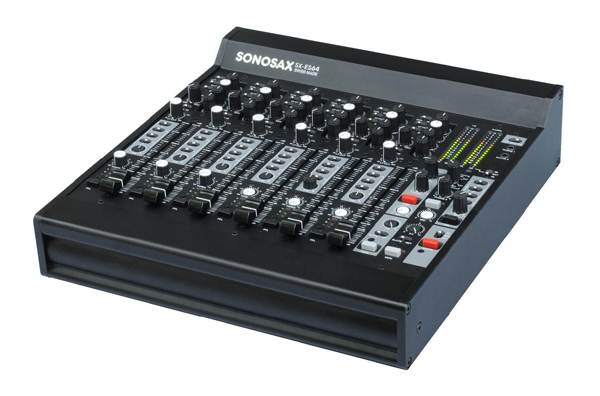
The next impression is its compact size; smaller than you’d guess. Its downward evolution from the larger older brother (but still compact) SXST mixer reminds me of how Mark Twain once ended a long letter: “If I had more time, it would have been shorter”, he said. Well, evidently Sonosax took the time to make the new ES64 small, which may be a perfect size for most of what we use a mixer for.
It clearly fills the void left by the discontinued Cooper 306 compact mixer, but it does so with more capability, in a more compact package, while maintaining very high audio quality–and all at a lower price. What a very nice surprise.
Even after all these of things are processed, it’s still difficult to stop looking at it. Satin black finish, milled aluminum frame, understated white and gray labeling… This mixer could be hung on the wall of an art museum and draw a crowd.
 The Basics
The Basics
Six mic/line inputs with limiters and optional EQ, six direct outs, four mix busses, eight AES outputs (optional), four return inputs, two additional outputs and return inputs on optional 10-pin ENG connector, and complete monitoring options for the recordist and the boom operator including private communications. Powered internally by four D cells or externally by 6-18VDC through a standard 4-pin XLR.
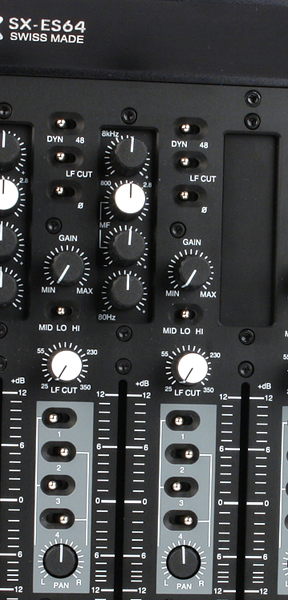
Just under the EQ section is a Low Cut knob that sweeps out the lows from a range of 25Hz to 350Hz at 12dB/oct. Just about right. And if cutting below 25Hz is still too much, the Low Cut filter can be switched out completely. Perfect.
Also at the top of each input is a switch for dynamic or 48V phantom. But, thankfully, there is no “T” power option. Since there has not been a T powered microphone made in this century (and no need to make one), I’m glad to see the option gone. Facilitating T powered microphones could require stricter noise specs for the internal power supply, and more circuitry and switches, all of which would needlessly raise the cost for the vast majority that do not use T power mics. Another wise choice by Sonosax.
Control
Input trim is controlled by a three-position switch for course adjustment and a rotary pot for fine adjustment. This is not quite as precise as the 12dB course adjustment steps found in its big brother, the Sonosax SX-ST, but for the operator the 3-position switch might actually be better. It is more likely that the desired input range can be covered via the rotary switch without also clicking through multiple course adjustment steps. With prefader metering on each input, the levels are very easy to manage for optimum gain structure.
Each input has the famous Sonosax soft-knee limiters built in. Those who have used these limiters while recording live dialog (like myself) swear by them because they control peaks very well without drawing attention to themselves. But they do more than just prevent overload. When mixing six microphones of six excited actors, these limiters can help create a much smoother mix than when using human fingers alone. Operation is simple: the attack time, release time, and compression ratios are fixed, while the position of a threshold control knob determines at what level the limiter starts to work.
Time for another surprise. When the faders are moved, they’re not just smooth, they’re slick! Sonosax does not tout the brand name, but they are not Penny and Giles faders; they are smoother. These are the same 100mm conductive plastic faders used on the SX-ST. Every time I’ve seen someone move these faders for the first time they smile in amazement.
Signal Routing
The acceptance of multi-track recording for location production has added importance to a mixer’s ability to handle complex signal routing, and to make changes quickly when under pressure to roll. The ES64 has this requirement covered on the same level as the larger, more complex, SX-ST.
Each input has its direct output that can be pre-EQ, post-EQ, or post-fader. Each input can also be assigned to any combination of the four output busses, in any combination of prefader and/or postfader. This ability is important to accommodate the established convention of “mono mix on ch1, prefader ISOs on remaining tracks”. Also like the larger SX-ST, the ES64 can allow independent assignment of inputs and mix busses to the eight digital outputs (AES option required).
In Practice
On a practical level, here is an example of how this routing could be used:
Recorder #1 (8-TRK), using the digital outputs: Mono mix on TRK1, Boom #1 on TRK2, Boom #2 on TRK3, Wireless mics 1-4 on TRK4-7
Recorder #2 (4-TRK, backup): Using the analog outputs: Mono mix on TRK1, Boom #1 & Boom #2 on TRK2, Wireless 1-4 on TRK3
Camcorder: Mono mix on TRK1, Boom#1 on TRK2 (through the 10-Pin HRS output).
This is an incredible amount of utility for such any portable mixer, especially as compact at the ES64, and with sonic quality that is arguably unsurpassed by any such device. And though there is not a bus labeled “AUX”, it’s just a matter of how the outputs are used; because even with all of these signals coming and going in the above example, mix bus-4 is still available to feed Video Assist or EPK their own mix.
After receiving comments about the larger SX-ST mixer’s lack of an internal slate/talkback mic, it’s good news that the smaller ES64 found the room; but evidently at the expense of an external slate/talkback mic input. Oh well… Since the mixer is small, its pieces can’t be very far from the operator, including the internal slate mic, so it doesn’t sound so far away.
 Look
Look
Making a mixer this compact (and this inexpensive) meant eliminating moving needle meters. Therefore, all metering is by LED. The four main LED meters on the master section are of high enough resolution that the bouncing needles will not be missed. The meter scale, however, will take some explaining to the unfamiliar. The top of the scale is “12”, and 12db below that is a “0”. But 12dB of headroom for recoding original dialog track is not enough (20dB is the accepted amount). Therefore, the appropriate 0VU reference on these meters is 9dB below the 0, which is 21dB below the meter’s full scale. This means that a tone from this mixer that registers “-9” on its scale should line up with -20dBfs on a digital recorder. This is the same scale that is used on the larger Sonosax SX-ST mixer, which I’ve found easy to use once it’s understood.
 Listen
Listen
There are two monitoring circuits. The first is intended for the mixer/recordist, and the second is intended for control room monitoring or for a boom operator. Finding the best way to monitor multiple mix busses seems to be a challenge. Monitor #1 is complete and allows for listening to each mix bus, alone, in both ears. This is important since most recordists (including myself) usually listen to the mono mix. But monitor #2 (which will typically be used for the boom operator) cannot do this. No doubt designed to facilitate controlroom monitoring, the monitor #2 circuit has selections for stereo and mono, but only in pairs (1&2 or 3&4). This can be a nuisance for the boom op who usually needs to hear either only the mono mix or only their microphone. For the way I work on a production, this will require an adapter switch box to send a single signal to both ears of the boom operator. I’ll soon be looking into the possibility of altering Monitor 2’s switch to select mix busses individually so that the boom op can hear one mix buss at a time.
The private line circuit provides a mic level input for the boom operator’s talkback mic that can be keyed remotely by the boom operator with the same belt-worn box (Remote Audio Boom Box for Sonosax) used with other Sonosax mixers. However, the new ES64 uses a 6-pin XLR headset connection instead of the 6-pin Binder connector, so a different mixer end fan-out would be needed.
In the casual listening tests, using the very quiet Sennheiser MKH-8040 microphone, the preamps of this mixer are quiet and crystal clear, in part due to its low distortion transformerless input design. There is more than ample gain (80dB according to the manual) for use with the usual condenser microphones, and even lower level dynamic microphones.
The AES converter option provides eight additional outputs that can be either direct outputs of each input or mix bus outputs, which is determined at the time of installation, but the configuration is for AES output 1-6 to be the direct outputs, and AES output 7-8 to be mix busses 1&2. The converters can run at 48K or 96K, and may be synchronized by external word clock via SMA connectors on the back panel. This external sync ability will help facilitate the pull-up/pull-down sampling frequencies of 48.048 and 47.952 when using recorders that do not use sample rate conversion.
Power
In high-gain, low-noise, portable mixer design, low power consumption is a challenge, especially when internal battery operation is an option. Sonosax not only succeeded with amazing low power specs, but also added a power economy mode to stretch battery life even further. When in “ECO” mode (center position of the power switch) the meters only use one LED to indicate level. With a 0VU reference tone on all four outputs, when powered by an external 13.8V, our ES64 mixer pulls only 600mA (0.6A) in ECO mode, and only 700mA in normal mode. Granted, this is without condenser mics and without the optional AES converters, but this is very fuel efficient for such high performance.
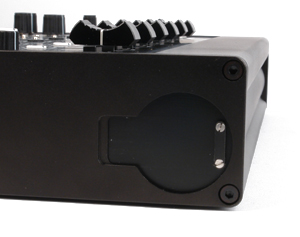
The Beginning
The Sonosax SX-ES64 is brand new, but built on revered technology refined by decades of experience as a leader in the industry. It is clearly an important advancement in portable equipment that professional sound recordists use on location, It meets and exceeds the complex requirements of multi-track field recording, and I’m betting we will continue to see them used by happy owners 20 years from now (our service department still maintains earlier Sonosax models that are over twenty years old).
We now have several very good modern mixer choices for our specialized field. But when looking for a mixer with the range of features and abilities of the ES64 in a package this compact, the only choice is also a great one.
One comment
Leave a reply Delete Message
You must be logged in to post a comment.


 US
US  Canada
Canada 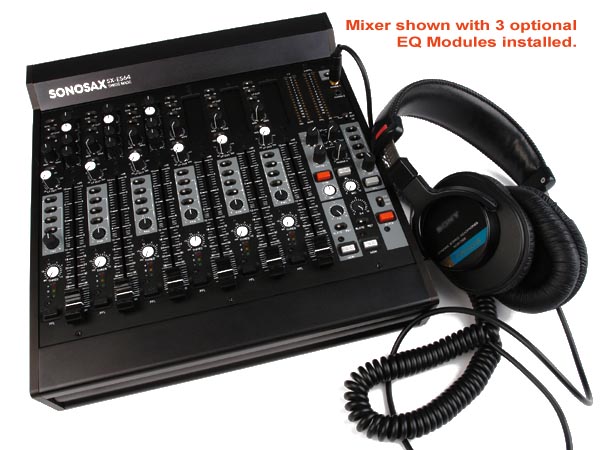
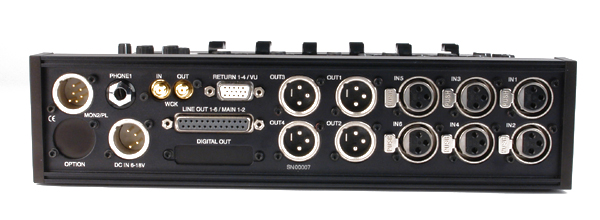 The Basics
The Basics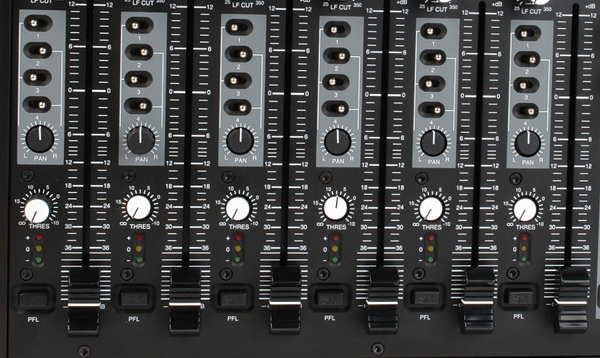
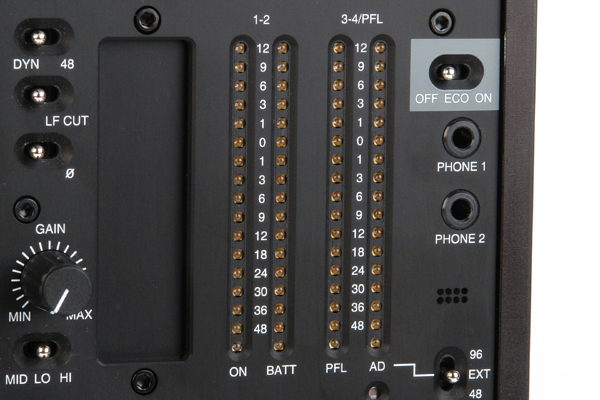 Look
Look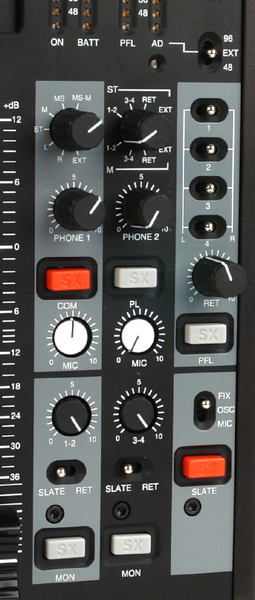 Listen
Listen
Have you figured out the mod to Monitor 2, yet?
If so, what are the costs for this mod?